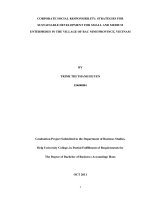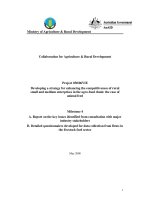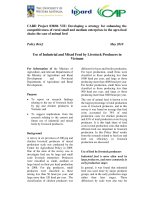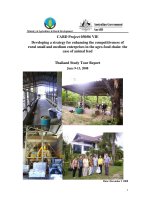corporate social responsibility strategies for sustainable development for small and medium enterprises in the village of bac ninh province, vietnam
Bạn đang xem bản rút gọn của tài liệu. Xem và tải ngay bản đầy đủ của tài liệu tại đây (433.46 KB, 69 trang )
1
CORPORATE SOCIAL RESPONSIBILITY: STRATEGIES FOR
SUSTAINABLE DEVELOPMENT FOR SMALL AND MEDIUM
ENTERPRISES IN THE VILLAGE OF BAC NINH PROVINCE, VIETNAM
BY
TRINH THI THANH HUYEN
E0600084
Graduation Project Submitted to the Department of Business Studies,
Help University College, in Partial Fulfillment of Requirements for
The Degree of Bachelor of Business (Accounting) Hons
OCT 2011
2
DECLARATION
I hereby declare that the graduation project is based on my research and experiences
except the acknowledged aquotations and citations. And, this graduation project has
not been used at previously or concurrently submitted for any other course/degree at
Help University College or other institutions. The word count is 10,968 words.
_____________________
TRINH THI THANH HUYEN
Date: October 2011
3
CORPORATE SOCIAL RESPONSIBILITY: STRATEGIES FOR
SUSTAINABLE DEVELOPMENT FOR SMALL AND MEDIUM
ENTERPRISES IN THE VILLAGE OF BAC NINH PROVINCE, VIETNAM
By
TRINH THI THANH HUYEN
Oct 2011
Supervisor: Dr. Le Van Lien
ABSTRACT
The constantly innovation to improving the ability to adapt to the trend of sociaty is
one of the leading principles in today’s business world. During the renovation of the
country, Vietnam has faced to many challenges on the economic, political, social,
environment, culture Especially on 7/11/2006 Vietnam has become a member
150th of World Trade Organization (WTO). The business man face to challenges,
competition which will take place more severe, more competitors at broader and
deeper level. That is the competition between the products in the market, between the
domestic businesses and the international market.
Relate to fact of small and medium enterprises, cooperatives, manufacture owners in
the village of BacNinh face to a lot of difficulties in the business because small-scale
trading, market relationships are limited, public management is still insufficient, the
application of information technology is poor, they do not know where to start, yet?
4
How the growth of businesses like? How to develop product? How to competitive?
The development of enterprises which had difficulties when it is more and more
difficult to determine a direction for sustainable development, long-term benefit for
the enterprise itself and managers.
Besides, the challenges of the 21st century such as weather change, declining natural
resources, and energy crises as well as business requirements of small and medium
enterprises to change the basic way they operate. It is no longer acceptable simply to
maximize profits in the short term. Instead, businesses must pay attention to the
impact of economic, social and environmental aspects of their activities - known as
sustainability or corporate social responsibility (CSR).
The purpose of this study is to discuss the role of CSR in helping small and medium
enterprises in the villages of Bac Ninh - Vietnam to achieving competitive
advantage. Also research and synthesis, analysis, logic, strategy and business
development for small and medium enterprises in villages in Bac Ninh province -
Vietnam. Simultaneously suggest directions and solutions to promote business
development of special attention to products with different villages of products to
create sustainable development for the enterprises.
5
TABLE OF CONTENTS
Declaration
Abstract
Table of content
List of figures
Chapter 1 INTRODUCTION
1 Definitions
1.1 The definition of sustainable development
1.2 Some models of sustainable development
1.2.1 Three circles model of economic and social,
environment of intersection of Jacobs and Sadler
(1990)
1.2.2 Carroll's 1979 conceptualization
1.2.3 Model of three target groups of economic, social
and environment of World Bank
1.2.4 The model of sustainable development in Vietnam
1.3 Small and medium enterprises
1.4 Villages, traditional villages
Chapter 2 LITERATURE REVIEW
2.1 Model three - level analysis, PEST model
2.1.1 Economic environment
2.1.2 Environmental technology
Pages
2
3
5
10
11
11
11
12
12
13
14
14
15
16
17
17
18
18
6
2.1.3 Socio-cultural environment
2.1.4 Natural Environment
2.1.5 The political and legal environment
2.1.6 Global Environment
2.2 General analytical model inside and outside – SWOT
2.2.1 SO strategy
2.2.2 WO strategy
2.2.3 ST strategy
2.2.4 WT strategy
Chapter 3 RESEARCH METHODOLOGY
3.1 Research objective
3.2 Research methodology
3.3 The scope of research
Chapter 4 ANALYSIS AND DISCUSSION
4.1 Overview of small and medium enterprises in craft
villages in Bac Ninh
4.2 PEST model applied to analyze the business
environment of the handicraft industry of small and
medium enterprises in the village of Bac Ninh.
4.2.1 Environmental politics and law
4.2.2 Economic environment
4.2.3 Environmental science and technology
4.2.4 Socio-cultural environment
19
19
20
20
21
23
23
23
23
25
25
25
26
27
27
33
33
34
35
36
7
4.2.4.1 Society of the population and labor
4.2.4.2 Population quality
4.2.4.3 Cultural Environment
4.2.5 International Environment
4.3 The key issues related to the current situation and
development prospects of small and medium enterprises in
craft villages in Bac Ninh: Identify strengths, weaknesses
and determine opportunities and challenges; Position the
stand point of industry
4.3.1 Current Competition
4.3.1.1 The pressure of new businesses entering the
market.
4.3.1.2 Pressure from customers
4.3.1.3 The pressure of suppliers
4.3.1.4 Competition among same field enterprises
4.3.2 The factors in the industry
4.3.2.1 Relations with investors and representatives of
customers, relationship with joint venture partners
4.3.2.2 Manufacturers Capability
4.3.2.3 Organization of production
4.3.2.3 Criterion on price
4.3.2.4 The ability to provide credit, capital
4.4 Apply the SWOT model to evaluate the general
position of small and medium enterprises in the villages in
Bac Ninh
36
37
37
38
39
39
39
40
41
42
43
43
43
44
44
44
45
46
46
8
4.5 Competitive strategy and strategic options
development of small and medium enterprises in the
villages in Bac Ninh
4.5.1 SO (strengths - opportunities)
4.5.2 ST (strengths - threats)
4.5.3 WO (Weakness - Opportunities)
4.5.4 WT (Weaknesses - Threats)
Chapter 5 RECOMMENDATIONS, SUGGESTIONS
5.1 Strategic Orientation for Sustainable Development of
small and medium enterprises in Bac Ninh
5.1.1 Vision
5.1.2 Mission (functions)
5.1.3 The strategic objectives in 2011 and 2020
5.1.4 The strategy function
5.1.4.1 Product development strategy to make a
difference, combining traditional elements with modern
elements, preserving the national identity
5.1.4.2 Strategy for raising capital for businesses
5.2 A number of measures to improve management
structure and resources of small and medium enterprises in the
villages in Bac Ninh.
5.2.1 On the market
5.2.2 Technical solutions
5.2.3 Solution of labor
47
48
48
49
49
49
49
50
50
51
52
53
53
55
55
56
57
9
5.2.4 Solution development and combination of
economic, production and business organizations.
5.2.5 Some measures to improve the layout using the staff
and management mechanisms
5.3 Recommendations to address existing problems
5.3.1 For businesses
5.3.2 For industry - State and local
5.4 Proposed measures to reduce environmental pollution
5.4.1 Worker training and awareness of people
5.4.2 Production planning area
5.4.3 Planning the village towards the development of
cultural tourism
5.4.4 Planning within the enterprise
5.4.5 The technology measures
5.4.6 Management Environmental of dirty water
5.4.7 Solid Waste Management
5.4.8 Management of air pollution
5.4.9 Solutions to environmental management
Chapter 6 CONCLUSION
58
58
58
60
61
61
62
62
63
63
64
64
65
67
10
LIST OF FIGURES
Figure
Title
Page
Chapter 1
Figure 1.1
Figure 1.2
Figure 1.3
Figure 1.4
Chapter 2
Figure 2.1
Chapter 3
N/A
Chapter 4
Figure 4.1
Figure 4.2
Figure 4.3
Figure 4.4
Chapter 5
NA
Chapter 6
NA
Three circles model of CSR
A hierarchy of CSR (adapted from Carroll, 1991)
Three target groups of CSR
The model of CSR in Vietnam
Analysis of factors inside and outside
The medium and small villages in BacNinh province in
2008
Value of production of small and medium enterprises in the
villages in BacNinh
Number of enterprises in the village
Number of households - labor small industry production in
2008
NA
NA
12
13
14
14
22
28
30
30
31
11
Chapter 1
INTRODUCTION
1. Definitions
1.1 The definition of sustainable development
Sustainable development is a new concept to define a development in all aspects of
the current which is to ensure continued development in the distant future. This
concept is currently targeted towards countries in the world, each country will base
on specific economic, social, political, geographical, cultural own strategy to best
suit that country. The term “sustainable development” first appeared in 1980 in the
publication World Conservation Strategy (published by the Association for
Conservation of Nature and Natural Resources International – IUCN) with a single
content.Simplified: "The development of mankind can not just focus on economic
development but also to respect the essential needs of society and the impact on
ecological environment."
This concept was popularized in 1987 by the Brundtland Report (also known as Our
Common Futur Report) of the Commission on Environment and Development World
- WCED (Brundtland Commission now). This report clearly sustainable development
as "development that meet the current needs without compromising the damage to
the ability to meet the needs of future generations " In other words, sustainable
development to ensure the effectiveness of economic development, social justice and
12
environmental protection and conservation. To achieve this, all economic sectors -
social, government, civil society to shake hands, make aim to reconcile three key
areas: economy - society - environment.
The concept of "sustainable development" is commonly known in Vietnam in the
late 80's early 90's. Although, appearing relatively late, but it soon be presented at
several levels. In recent years, aspects of sustainable development in production and
business activities of enterprises were more concerned. In five years, each year the
newspaper group's language newspaper Saigon Economy News were awarded
"Business and Sustainable Development" for foreign enterprises in Ho Chi Minh and
southeastern provinces.
1.2 Some models of sustainable development
1.2.1 Three circles model of economic and social, environment of intersection of
Jacobs and Sadler (1990)
Figure 1.1 - Three circles model of CSR
13
1.2.2 Carroll's 1979 conceptualization
Carroll's Pyramid is widely accepted and used in CSR literature and can be seen as a
mainstream conceptualization of CSR. In 1979, Carroll CSR Divided into four
separate areas: Economic, legal, ethical, and discretionary Responsibility. Each area
is presented as consecutive layer of pyramid in Figure 2.1 and briefly summarized
below:
Figure 1.2 - A hierarchy of CSR (adapted from Carroll, 1991)
14
1.2.3 Model of three target groups of economic, social and environment of World
Bank
Figure 1.3 - Three target groups of CSR
1.2.4 The model of sustainable development in Vietnam:
Figure 1.4 - The model of CSR in Vietnam
15
The carrying out of construction and operation concept of "sustainable development"
in accordance with the actual country and the world scene is of paramount
importance. Models of sustainable development in Vietnam is formed on the basis of
empirical research and, in accordance with the actual and desired by local managers.
1.3 Small and medium enterprises
Small and medium enterprises are the enterprises with small scale in terms of capital,
labor or revenue. Small and medium enterprises can be divided into three categories
based on size includes micro enterprises, small enterprises and medium enterprises.
According to the criteria of the World Bank Group, micro enterprises are enterprises
with the number of workers under 10 people, small businesses are the number of
employees from 10 to 50 people, while medium enterprises have from 50 to 300
labor.
In Vietnam, It is not depend on business sector, businesses with registered capital
below VND 10 billion or an average number of employees less than 300 people
annually are considered small and medium enterprises (under Article 5 of Decree
90/2001/ND-CP)
Kind of small and medium enterprises among the large proportion of enterprises in
Bac Ninh. A number of small and medium businesses are not concentrated in small
villages, traditional villages. With a significant contribution to the growth of local
economy, the business types in the village of Bac Ninh is the team unity called "the
small and medium enterprises in the village of Bac Ninh". Types include: Company,
Ltd., private enterprises, cooperatives, business households. Although this type of
business is legal framework of different activities, but they all have in common is a
16
positive contribution to the growth of the provincial economy, generating revenue
and solving the employment problem in local.
1.4 Villages, traditional villages
The village is a cluster of residents in a village (the village) has one or several lines
are removed from production agriculture to independent business, is the village non-
agricultural sectors dominate the household, number of employees, and the income
from farming.
Traditional villages are villages appear long ago in history and still exist today, as the
village has existed for hundreds of years, even thousands of years, is closely related
to factors traditional and popular experience has been accumulated over many
generations back, the paper Phong Khe commune, Dong Ho folk paintings, pottery
Luy Lau.
17
CHAPTER 2
LITERATURE REVIEW
2.1 Model three - level analysis, PEST model
The side effects in three levels: international, national and local relevant.
The content of impact analysis (analysis of Pets):
Impact Areas
Content
Influence to
Politics (P)
- The political stability
- The political line
- Direction
- Population and investors psychology
Economy (E)
- Economic policy
- Economic condition
- Investment Environment
- Development conditions
Technology (T)
- The development of science and technology
-Research and development
- Competitiveness
- Economic effective
Social (S)
- Trend of social development
- The social criteria
- Investment Environment
- Economic development direction
PEST model used to analyze the macro environment of business. Firms must be
analyzed to understand the opportunities and challenges that are of the external
environment affect business. Factors: Culture and society, politics, law, economics,
technology is shown through modeling PEST.
18
2.1.1 - Economic environment
Current situation and economic trends affecting the future success of business
strategy, the key factors that businesses usually analyzed are: The growth of the
economy, interest rates, exchange rate and inflation rate. As the economy in periods
of high growth will create many opportunities for investment in production
expansion of enterprises, whereas when the economy is in recession reduced to
reduce the cost of consumables increases the forces of competition. Usually, when
the economy decline will become reason of war in the price of the manufacturing
sectors, especially the adult industry. Interest rate will determine the level of
investment for enterprise products. Monetary policy and exchange ratio can also
create a good Olympics for business, but also as risk factors for the development of
them. Inflation and fight inflation problem is also an important factor to consider and
analyze. In fact, if high inflation is to control prices and wages may not master
inflation, investment projects become more risky enterprises would lead to reduced
investment enthusiasm, production development. Thus inflation is a threat to the
enterprise.
The level of economic development is the size, speed economic development of
countries and regions including: GDP, GNP, annual growth, this analysis helps
businesses understand the development trend of the economy.
2.1.2 - Environmental technology
The small and medium enterprises in the village of BacNinh has adapted to the new
mechanism from back in 1986 with market mechanisms and policies, enterprises
have invested heavily in advanced technology application, transfer new technology,
19
modern manufacturing processes to modernize traditional technologies, replacing
outdated technology with craft of modern technology in order to improve
productivity, increase business efficiency, more moved his business, replacing old
products with new products. Most enterprises in Vietnam – Chau Khe - Tu Son has
moved from production to production wrought iron and steel, in Phong Khe outside
firms to maintain production of traditional goods such as paper, writing paper Han
Nom They have invested heavily in new technology, the production line paper,
writing paper, duplex paper, packaging of all kinds
2.1.3 - Socio-cultural environment
The small and medium enterprises in the village of Bac Ninh has adapted the trend of
the times, businesses have kept the characteristics of the traditional products,
products with artistic traditions of each villages, it is the traditional symbol of the
people of Vietnam, the village has products preferred by customers as competition
Dai Bai, Dong Ho folk paintings, furniture Dong Ky.
2.1.4 - Natural Environment
Bac Ninh has natural conditions, a favorable geographical position have created for
the Bac Ninh region soon became an agricultural civilization long development, a
unique cultural region, represents a unique Kinh Bac region (Northern of Vietnam).
The businesses in the village have been promoting their intellectual inheritance of the
essence of his father left, forming the well-known products such as ceramic Luy Lau,
20
Dong Ky furniture. Besides, businesses know using the advantages of natural
conditions for its development strategy produced a long-term business
2.1.5 - The political and legal environment
The main elements of government and politic influent to the operation of the
business wider and deeper. The enterprise must comply with tax regulations, lending,
hiring, safety, pricing, advertising, plant location, environmental protection, joint
venture or cooperation.
Political stability, the consistency of policy stance is always a major attraction to
investors, the legal system is built will be the perfect opportunity to stable business,
such laws protect environment is that businesses must consider.
With the stable political and laws environment at Vietnam, in Bac Ninh province has
planned industrial zones 54 villages enabling manufacturing enterprises to focus,
away from residential areas, the protection environment requires the attention of the
State, and the associated responsibilities of business.
2.1.6 - Global Environment
The Vietnam joined ASEAN, APEC, WTO and has officially become members of
organizations that create more business opportunities, playing, enjoying most-
favored nation, do not treat you particularly international trade, but the challenges of
world competition more fierce.
21
The small and medium enterprises in the village of Bac Ninh province has created a
own play-ground by the export way. But the difficulties and challenges of small and
medium enterprises in craft villages in Bac Ninh is the product also offers the single,
not uniform, international law is ignorant, weak command of foreign languages
processing, the brand on the market do not have, resulting in the export business was
going through the intermediate steps which leads to reduced productivity
effectiveness.
2.2 General analytical model inside and outside - SWOT
This model is analyzed both within and outside the enterprise (SWOT):
S = Strengths, W = Weaknesses, O = Opportunities, T = Threats.
Considering these factors both inside and outside which play an important role
because they help clarify the business environment as well as working on better
visualize your desired future. SWOT Analysis is the key to strategy development, to
clarify the strength of the enterprise, the weaknesses of the business.
22
The specific target for analysing of the inside and outside factorsin the enterprises
from which we form strategic business development division.
Figure 2.1 - Analysis of factors inside and outside
Matrix strength - weakness, opportunity - thread (SWOT)
Matrix strength - weakness, opportunity - threats is an important tool in combination
it can help managers develop four types of strategies:
+ Strategy strengths - opportunities (SO)
+ Strategic opportunities - weakness (WO)
+ Strategy strengths - threats (ST)
+ Strategic weaknesses - threats (WT)
The combination of important elements inside and outside is the most difficult task
of developing a SWOT matrix, it requires a good judge and will not have a mix is
The external factors
- Customers
- Price competition
- Competitions
- Distribution
- Technology
- Macroeconomics
- Laws, policies, culture
- Working style
- The main style
- Supplier
-
- Risks and oppotunities
The interal factors
- Current capacity (capital, raw
materials)
- Current power
- Cost structure
- Product and investment portfolio
- Research and development
- The level of technical proficiency
- Staff abilities
- Business culture
-
- The strengths and weaknesses
Specific
objectives
Strategy
23
best. The diagram above shows the strategy combined SO, ST, WO, WT are as
follows:
2.2.1 SO strategy
SO Strategies use strategies within the enterprise to take advantage of external
opportunities. All managers are keen to organizations where their strengths can be
used inside to take advantage of the trends and events of the external environment,
typically the organization will pursue war WO strategies, ST to hold can be in the
position where they can try to overcome to make them become strengths when
businesses have to deal with the significant threat they will seek to avoid the threat it
can focus on the opportunities.
2.2.2 WO strategy
WO strategy to improve internal weaknesses by taking advantage of external
opportunities. Sometimes, great opportunities exist outside the enterprise but internal
weaknesses prevent it from exploiting this opportunity.
2.2.3 ST strategy
ST strategy is to use the strengths of the business to separate out or reduce the impact
or external threats. This does not mean a business has always faced strong threats
outside.
2.2.4 WT strategy
WT strategy is strategy defensive approach used to reduce the weaknesses and avoid
threats from the outside environment. Some organizations cope with a multitude of
external threats and internal weaknesses can businesses unsafe situation at all. Actual
24
business enterprise so often struggle to survive, links, limit spending, declared
bankrupt or subject to insolvency.
25
CHAPTER 3
RESEARCH METHODOLOGY
3.1 Research objective
The research is designed and used models to analysis and synthesis
of theory, strategy and business development at the small and medium enterprises in
the village of BacNinh province, Vietnam.
The research applied the theories and models to analyze and assess the actual
situation of production and business of small and medium enterprises in craft
villages in Bac Ninh province and strategydevelopment towards modernization.
From that identify the general point, impact the proposed solution is mainly to
promote businessdevelopment, paying special attention to the villages of
products (product differentiation)to create the sustainable development of small and
medium enterprises in the province of BacNinh province.
3.2 Research methodology
The research methodologies were used in this research such as:
- Qualitative research method survey, expert methods.
- Methods for meta-analysis, comparing statistics.
- Methods of data collection.









